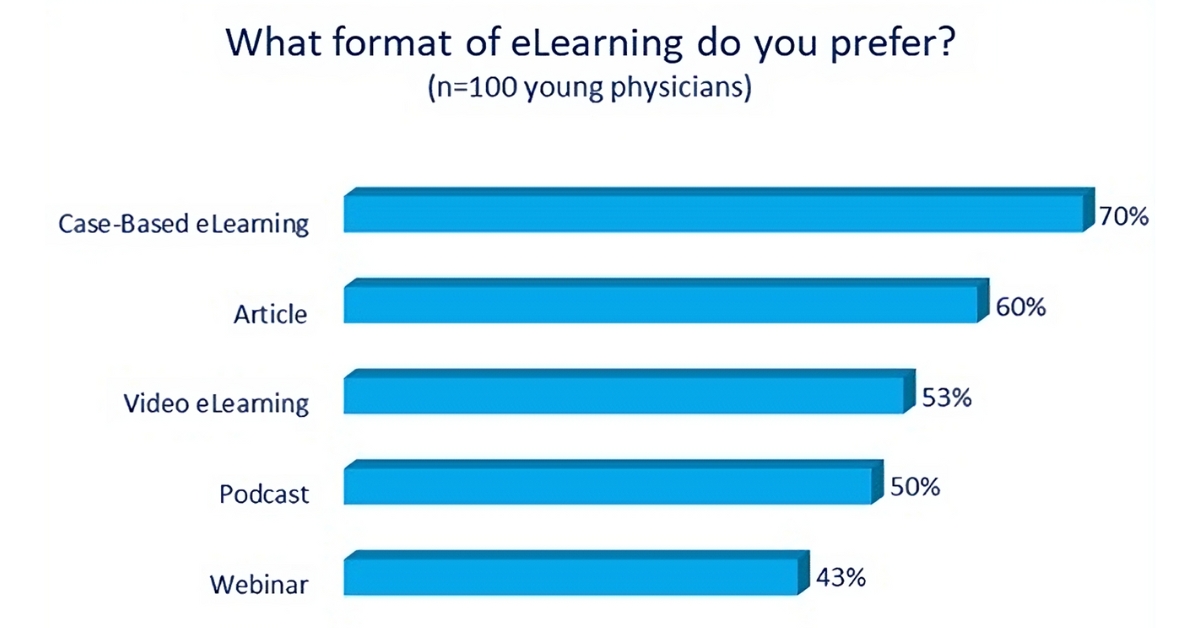Physicians’ preferences for e-learning formats can vary depending on their individual learning styles, preferences, and specific educational needs.
We have summarized some of the most popular formats for online continuous medical education (eCME) that we at CredoWeb have observed to effectively engage physicians.
Video lectures:

Video lectures are a common and widely used format in e-learning.
They allow physicians to watch and listen to experts delivering educational content, making it easier to understand complex topics and procedures.
How to increase effectiveness of video lectures:
- Invite engaging presenters who are knowledgeable and passionate about the topic.
- Invest in professional production to ensure clear visuals and high-quality audio.
- Break content into shorter segments to make it easier to digest and watch during busy schedules.
- Use visual enhancements such as animated presentations and graphics to reinforce key points and clarify complex concepts.
- Provide captions or transcripts for the video to accommodate different learning preferences.
Bonus tips from CredoWeb’s experience:
- Use a professional medical advisor or journalist to help structure the content in an engaging way. Leading specialists are great at presenting the topic, but they often lack the knowledge of how to engage audiences effectively.
- Utilize professional video editing techniques. Video lectures often include presentations, and making them visually appealing can enhance engagement. Consider animating aspects of the presentations, frequently changing the focus between the speaker and the deck, and incorporating animated infographics.
- Choose the right title! Similar to newspapers, audiences are drawn to the title and the author. If you have already invited a recognizable lecturer, utilize a professional medical journalist to help you write an enticing title to maximize the impact of the eLearning.
Interactive modules:

Interactive modules provide an engaging and more memorable learning experience.
These modules often include multimedia elements such as videos, case studies, quizzes, and interactive exercises.
Physicians can actively participate and apply their knowledge in a practical context.
How to incorporate interactivity in eCMEs:
- Create interactive scenarios that simulate real-life patient encounters. Physicians can navigate through the scenario, learn at each step of the case, make decisions at different points, and witness the consequences of their choices.
- Encourage physicians to engage in virtual discussions with their peers to analyze patient cases. This promotes collaboration, knowledge sharing, and diverse perspectives on managing complex patient scenarios.
- Incorporate polls in eLearnings to gather physicians’ opinions and allow them to compare their answers with their peers.
- Utilize patient cases as the basis for assessments, providing an engaging and practical approach to evaluating physicians’ understanding and competence. Grant certificates of completion for successful completion of eLearning modules based on patient cases.
Bonus tips from CredoWeb’s experience:
- When creating polls, consider asking about physicians’ experiences, such as encounters with similar patients or the use of specific drugs. This can provide valuable market feedback and insights.
- The most effective way to make an eLearning interactive is by combining different elements. A successful model often includes a video talk by a leading expert introducing a topic, followed by an interactive patient case, and concluding with a test or a poll
- Interactivity can also be built over time. Developing an online course or academy with regularly added learning materials invites participants to interact with various topics and formats within the same space, creating an ongoing learning experience.
Case-Based eLearning for Physicians:

Patient scenarios are highly valuable for practicing clinical skills and decision-making.
By presenting physicians with detailed patient histories, symptoms, diagnostic results, and treatment options, they can engage in experiential learning within a safe environment.
Physicians have the opportunity to work through the case, analyze the information provided, and make decisions based on their medical knowledge and expertise.
How to improve case-based eLearnings:
- Choose cases that are relevant to the target audience and represent common or challenging scenarios encountered in clinical practice. This ensures the content is meaningful and applicable to physicians’ day-to-day work.
- Introduce each case with comprehensive background information, including patient demographics, medical history, presenting symptoms, and relevant diagnostic findings. This provides a holistic understanding of the patient’s condition and helps physicians approach the case effectively.
- Enhance the cases by including relevant images, videos, diagnostic reports, and lab results. These multimedia elements make the cases more realistic, engaging, and reflective of real-world clinical practice.
Bonus tips from CredoWeb’s experience:
- When designing an eLearning with multiple patient cases, start with simpler cases and gradually increase the complexity. This approach allows physicians to adjust to the format and actively participate throughout the learning process.
- Utilize platforms that enable decision points within the case, where physicians can make choices or recommend treatment options. Show them the consequences of their decisions and provide feedback accordingly, fostering a sense of accountability and reinforcing learning outcomes.
- Provide access to relevant resources such as videos featuring leading specialists clarifying specific aspects of the treatment or diagnosis. This enriches the learning experience and offers additional perspectives from renowned experts.
- Plan for live round-table discussions where leading specialists can analyze patient cases that have been voted as the most interesting. Inform the key opinion leaders (KOLs) about what physicians found intriguing or challenging in these cases, which enhances the relevance and engagement of the discussions.
Webinars and Virtual Conferences:

Webinars and virtual conferences offer real-time learning experiences where physicians can attend live presentations, interact with speakers, ask questions, and participate in discussions.
These formats provide valuable opportunities for engagement, networking, and staying updated on the latest developments in the field.
How to increase effectiveness of webinars and virtual conferences:
- Incorporate interactive elements throughout the event to keep participants engaged. Utilize live polls, Q&A sessions, and chat features to encourage active participation and interaction among attendees.
- Invite speakers who can effectively deliver the content and engage the audience. Unlike pre-recorded video eLearnings, webinars are live events, and the speaker’s ability to present comfortably in front of an audience and captivate their attention is crucial.
- Ensure that the webinars and virtual conferences meet the necessary requirements for continuing education credits. Certified eLearnings tend to attract more attention and participation compared to non-certified events.
Bonus tips from CredoWeb’s experience:
- Pay attention to the invitations and reminders you send out. Partner with experienced professionals who have a proven track record in building successful customer journeys through effective invitations and reminders, maximizing attendance rates.
- If your event is hybrid, remember that online viewers often outnumber the physical attendees. Make sure the event is designed to provide a great experience for virtual participants as well.
- Invest in visually appealing webinar setups. Utilize branded or tailored virtual studios to make your event stand out from the crowd and create a visually engaging experience for attendees.
- For a higher impact, consider building an on-demand learning course based on a series of webinars you have conducted. Combining the live event with an on-demand course increases the visibility and accessibility of your content, allowing physicians to access it at their convenience.
Collaborative Learning:

Physicians greatly benefit from collaborative learning approaches, including online discussions and virtual communities, which facilitate knowledge sharing, peer support, and learning from others’ experiences.
How to foster collaborative learning:
- Include a facilitator in the discussion, preferably an expert in the specific medical field who can moderate the conversation, share their own experiences, and provide valuable insights.
- Clearly define the topics of discussion to guide the conversation and provide structure to the collaborative learning process.
- Provide opportunities for interdisciplinary discussions, case presentations, or shared learning experiences. This encourages a holistic approach to patient care and deepens the understanding of different specialties’ roles and contributions.
Bonus tips from CredoWeb’s experience:
- Discussions can sometimes become chaotic. To foster effective learning, consider using a professional to summarize the key insights at midway and at the end of the discussion. These summaries help distill the main points and ensure participants derive maximum value from the conversation.
- Keep in mind that only a small percentage, around 5%, of participating physicians may actively comment and share their thoughts. However, this shouldn’t discourage you. Remember that many physicians will read and learn from the discussion. Prompt and reward active participants, but also recognize the importance of passive participants who benefit from reading and absorbing the content.
- Reward active participants by liking their comments and mentioning their names in the discussion summaries. Additionally, sharing statistics on how many times their opinions have been read can further motivate and engage participants, fostering a sense of recognition and accomplishment.
What do young physicians prefer?
We conducted a survey among 100 young physicians to gather insights into their preferences for eLearnings. The results revealed interesting trends in their preferred formats.
The overwhelming majority of respondents, 70%, indicated that they find case-based eLearnings to be the most engaging and effective.
This suggests that physicians appreciate the practical application of knowledge through patient cases.
Given their familiarity with reading large amounts of information, physicians tend to assimilate information faster when it is presented in a text format.
According to our survey, 60% of physicians expressed a preference for eLearnings that are text-based or have accompanying text, such as highlights or video captions.
This indicates a preference for learning materials that provide written content to support their understanding.
Video eLearnings have established themselves as the standard form of online education, with half of the surveyed physicians reporting participation in such courses.
Videos allow for visual and auditory engagement, making complex medical topics easier to comprehend.
Podcasts emerged as an emerging form of eLearning, reflecting the growing trend of learning on mobile devices.
However, incorporating visual elements such as images, graphs, and tables in podcasts can pose a challenge, as these visuals are integral to medical learning.
On the other hand, webinars were the least preferred format among young physicians, with only 43% of respondents voting in favor of them.
The fixed time of webinars often clashes with physicians’ busy schedules, making it challenging to attend live sessions.
To address this, it is crucial to offer on-demand access to webinars and carefully plan the timing of the sessions to accommodate more physicians.
By understanding physicians’ preferences for eLearnings based on our survey findings, we can tailor the delivery of educational content to better meet their needs and ensure maximum engagement and effectiveness.

Conclusion
It’s important to consider that a combination of different elearning formats might be the most effective approach.
Our experience with over 50 pharma companies shows that offering a variety of formats allows physicians to choose what suits their learning preferences and aligns with their educational goals.
Additionally, regularly collecting feedback from physicians and assessing their satisfaction and learning outcomes can help tailor e-learning formats to their specific needs.
CERTIFIED eLEARNINGS
Take learning to the next level with our intuitive online platform and experienced team that will help you organizecontinuous medical education that truly helps physicians.
- Full eLearning management – concept, video shooting, invitations and reporting;
- Support in accreditation of e-learnings and issuing participation certificates;
- Analysis of HCPs behavior and digital preferences.



